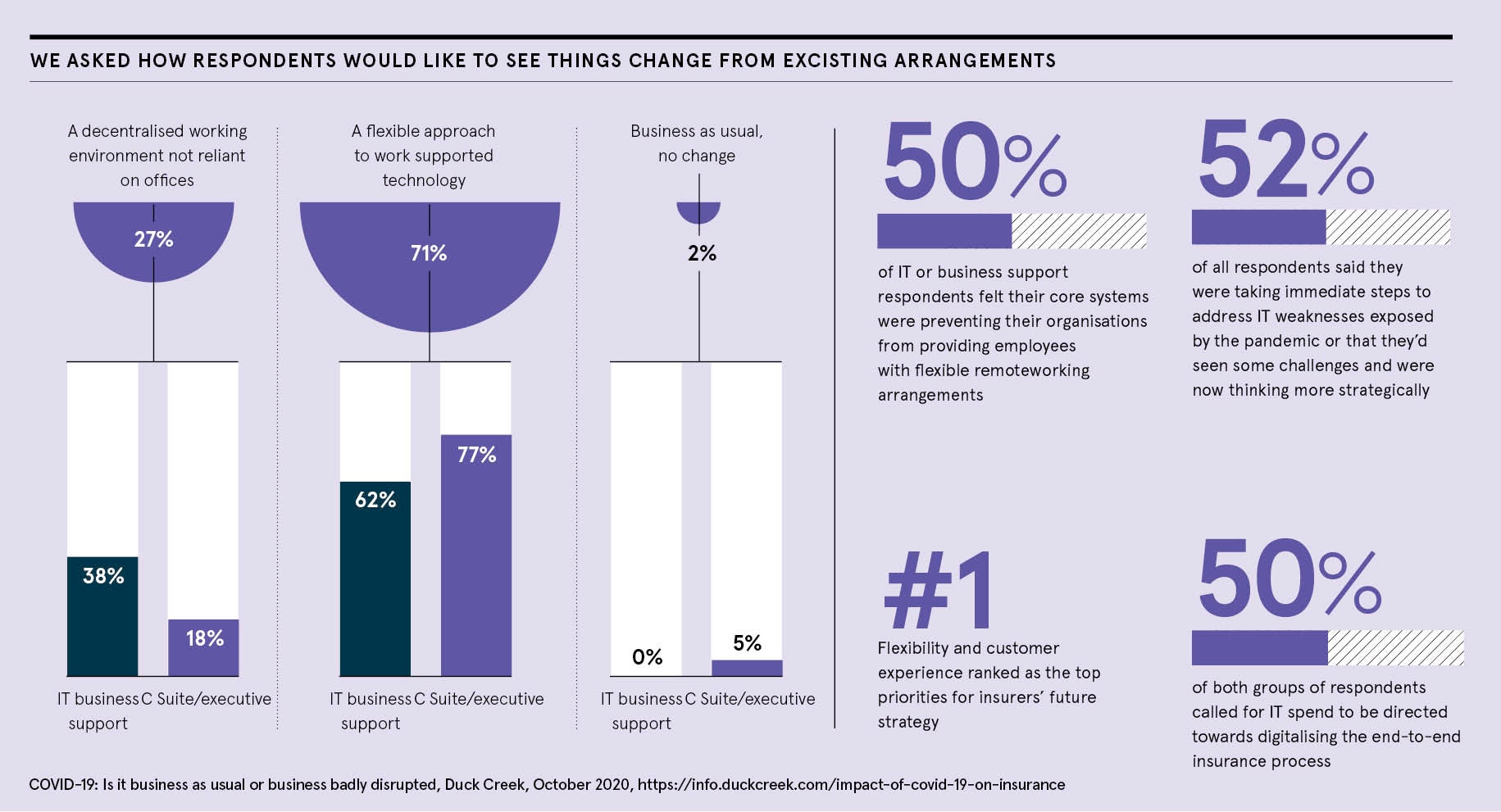SPONSORED BY Duck Creek
In many ways the pandemic is proving a catalyst for change in our industry, from a cultural shift towards more flexible, home-based working many would like to see continue at least in part in the future once lockdown restrictions are eased, to what has been a real wake-up call for many that their internal systems and processes must be resilient, flexible and future ready.
We conducted a recent independent survey of senior C-suite insurance experts and their IT division counterparts as we sought to hold a mirror up to reflect the impacts insurance businesses had seen internally due to remote working and the wider operational challenges presented by the pandemic, how they had adapted and what lessons they wanted to take forward into the future.
Daunting challenge
It’s clear that switching to remote implementations and digital processes has been easier for some insurance business than for others. However, maintaining business as usual, and achieving growth and launching new products in the current environment, may be daunting to some insurers whose systems are not set up to facilitate online negotiations and transactions.
For instance, our survey found that those respondents operating on-premises mainframe systems prior to the pandemic reported some challenges when it came to providing employees with flexible remote-working arrangements. Many respondents noted their companies spent the majority of their IT budget keeping the lights on and acknowledged that trying to mend or enhance their IT system was simply not going to solve future problems.
Supporting flexibility
In this new environment, the right architecture must be in place to support digitalising end-to-end insurance processes, a flexible approach to working and a streamlined virtual customer experience.
The time has come to clear out the old pile of leaves and opt for evergreen technologies, rather than adding to insurers’ existing legacy technology pile with new bolt-ons and workarounds that will not solve long-term innovation and flexibility challenges, and will ultimately only add costs and inefficiencies.
End-to-end digital services have been the norm in adjacent industries, such as banking and ecommerce, for over a decade, delivering enhanced client experiences and efficiencies, and providing businesses with the kind of agility they need to adapt to future opportunities and operating models.
The time has come to clear out the old pile of leaves and opt for evergreen technologies, rather than adding to insurers’ existing legacy technology pile
Many closed-box, on-premises systems are essentially out of date as soon as they are installed, as procurement processes can last months if not years, leading to the situation of automatically working with less up-to-date systems; in other words, installing legacy from the get-go.
In contrast, cloud-based software-as-a-service systems not only leverage the best available technology right at the point of adoption, but are also continuously delivering new functionality to solve the ever-changing insurance business challenges.
Fundamentally different approach
This on-demand, evolving functionality enables a fundamentally new approach to competing in today’s industry, one where technology supports strategy rather than dictating it, where the responsibilities for upgrades and keeping technology future ready lie with the provider and not the insurer, and where carriers are empowered to focus on innovation and delivering excellent customer service in entirely new ways.
These evergreen solutions must be platforms for innovation, designed from the ground up with this in mind: that they will have to change, to pivot with the customer and to support them on their journey. The future is an agile software ecosystem in the cloud and the industry is evolving quickly to get there.

Ecosystem approach
No one technology provider can cater for every specialty and this is where the insurtech ecosystem comes into its own. Cloud architecture allows a myriad of insurtechs to collaborate within an ecosystem to provide additional resources for every insurer and for each insurer to choose the resources that work for their own unique value proposition.
This ecosystem approach reduces friction for insurers by taking advantage of varied services, and replacing manual internal processes. The insurtech ecosystem also provides an enterprise view for significant functions like risk selection, data-driven pricing and superior risk management.
An ecosystem that can incorporate the best technology available, is open and adaptable and has change built into the heart of its architecture is what I mean by evergreen technology. And this technology concept is scalable and can deal with what insurers need to do at a market scale as well as for individual companies.
Our survey results were significant and give us even more confidence that we’re heading down the right path. It’s an exciting prospect. We are creating something game-changing for insurers and throwing the heap of IT infrastructure they’ve been hamstrung by in the past out of the window. For good.
For further information visit www.duckcreek.com
